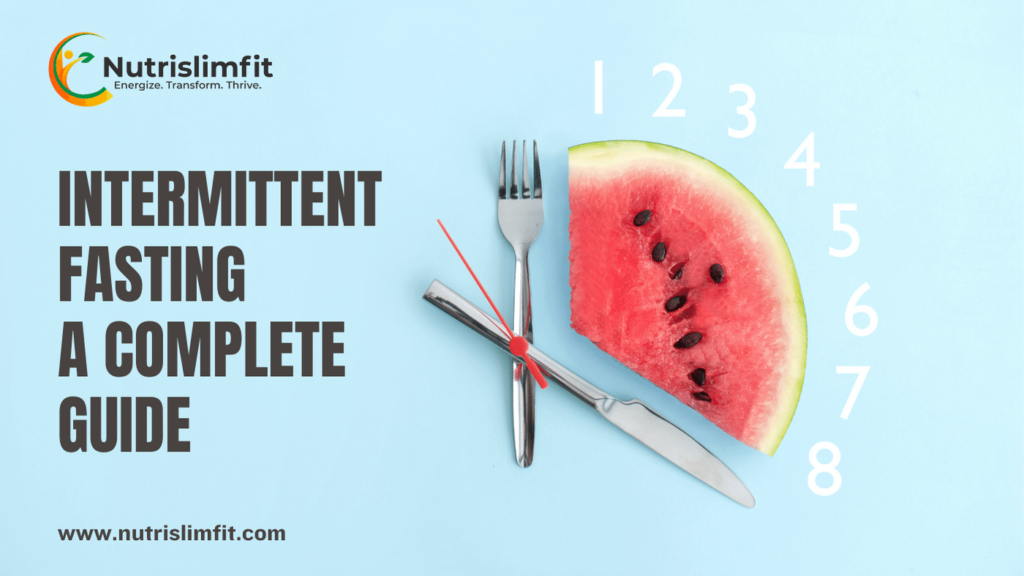Intermittent fasting (IF) has become an incredibly popular health and fitness trend. By cycling between periods of fasting and eating, IF promises benefits like sustainable weight loss, enhanced cell repair, decreased inflammation, and improved longevity. The simple concept aligns with our human evolution. Yet questions remain about doing intermittent fasting safely and effectively. This beginner’s guide covers all the essentials to help you use IF for better health.

What is Intermittent Fasting?
Intermittent fasting involves purposefully going extended periods without eating, cycling between fasting and eating on purpose. It differs from spontaneous fasting which might occur when you skip a meal accidentally. With IF, the idea is to create routine, planned fasts as part of your schedule. This gives the body a break from digestion, letting it tap into stored fuel and focus its energy on healing and renewal mechanisms.
There are different ways to approach:
Daily Time-Restricted Feeding
Eat all calories within a consistent 6-12 hour window daily, and fast the remainder. For instance, skip breakfast, eat lunch as your first meal then dinner before 8 pm.
The 16/8 Method
This IF style limits eating to an 8-hour window, fasting for 16 hours. For example, eat between 10 am-6 pm, fast overnight plus a few morning hours. It’s quite popular for simplicity.
Alternate Day Fasting
Fast every other day, limit eating to a 4-6 hour window on alternate feed days. This rigorous cycle demands supervising health factors.
The 5:2 Diet
Eat normally 5 days weekly, limit to 500-600 calories twice a week on your designated fasting days. This modulated approach appeals to many beginners.
Periodic Multi-Day Fasts
Zero-calorie fasts for stretches of 1-5+ days are performed periodically. Requires medical guidance and micronutrient supplementation. Attempts autophagy.
Fast Mimicking Diets
Very low calorie (800 or less) yet nutritionally-replete “fasting mimicking” diet plans lasting 5 days every 1-6 months. Formulated to invoke cellular benefits of fasting without full deprivation.
There are other interpretations too, but these methods form the basic styles of intermittent fasting people follow today for better health and body composition.
The Health Benefits of Intermittent Fasting
Beyond weight control, dozens of studies link various intermittent fasting protocols with numerous benefits:
1. Blood Sugar Regulation
By reducing insulin resistance and lowering blood sugar spikes, IF helps prevent and manage type 2 diabetes.
2. Heart Health
IF lowers cardiovascular disease risk markers like cholesterol and triglycerides, decreases blood pressure, and reduces inflammatory factors.
3. Brain Function
Studies associate IF with better cognition plus lower risks for neurodegenerative diseases like Alzheimer’s and Parkinson’s.
4. Anti-Aging
Fasting flips on maintenance and repair genes while curbing factors linked to aging like oxidative stress. Animal research shows dramatic lifespan extensions.
5. Cancer Defense
Animal models indicate fasting strengthens immune systems to prevent tumor formation. Ongoing human trials examine cancer therapy applications.
6. Cellular Protection and Renewal
Fasting gives cells a break from food energy to trigger autophagy, apoptosis, and stem cell-based regeneration.
The specific physiological benefits extending from fasting relate to these key mechanisms:
Ketogenesis
Fasts longer than 12-16 hours compel the body to burn stored fat for fuel, releasing water-soluble compounds called ketones. Mild ketosis provides potent anti-inflammatory effects and apoptosis.
Reduced Insulin-IGF-1 Signaling
Lowered insulin paired with very low IGF-1 growth factors during fasting prompts cells to repair themselves rather than grow continually. Genes activate for preservation and renewal.
Enhanced Cellular Autophagy
When fasting, cells recycle worn-out parts through a process called autophagy or “self-eating.” This clears cellular debris linked to many chronic and degenerative diseases.
Stimulated Neurogenesis
Research indicates fasting spurs the growth of new brain cells by as much as 400%. Better learning, memory, and mood may result from IF’s neural regeneration effects.
Activated Adaptive Stress Response
At the gene level, fasting turns on genetic repair and fortification mechanisms, making cells stronger and more resilient.
For maximum benefits, most experts recommend a 12-72 hours fast once weekly, often for 36+ hours depending on your current level of metabolic health. Fasting too frequently long-term may backfire by revving hunger hormones. Beginners should start cautiously under a health pro’s guidance.
Getting Started with Intermittent Fasting
Before embarking on an IF regimen, take sensible steps to launch a successful practice:
Check with Your Healthcare Provider
Make sure intermittent fasting fits safely within any medical conditions, medications, or low blood sugar issues. Very few specific conditions preclude IF when managed gradually. However, experts strongly advise connecting with your doctor before making major dietary switches.
Start Slowly and Progress Over Time
Avoid extreme fasting durations or calorie cuts at first. Begin with gentle 12-14 hour overnight fasts, building to 16:8 or a 24-hour fast once weekly. Listen to your body, going only as far as feels right. You can always intensify a fasting practice later. Regulate factors like electrolytes, calories, and nutrients on feed days.
Stay Hydrated
Drink ample pure water, herbal tea, and mineral-rich bone broth during fasting periods to support detox pathways and cellular cleansing. Sparkling mineral water boosts hydration quickly. Limit coffee and avoid sugary drinks or alcohol which could trigger hunger or blood sugar swings.
Pay Attention to Nutrition During Eating Windows
Nourish your body well during feeding periods. Follow a nutritious whole foods diet, properly balancing proteins, healthy fats, fiber-rich plants, probiotic foods, and anti-inflammatory spices like turmeric. Limit refined carbs, sugars, and processed items. Fasting permits dietary flexibility yet eating wholesome cuisine remains vital.
Consider Supplementation
Seeking guidance from an integrative or functional nutritionist allows room to Personalize fasting-adjunctive supplements like amino acids, minerals, phytonutrients, and probiotics based on your biochemistry, bloodwork results, and health goals.
Move Your Body
Incorporate light exercises like walking, Pilates, or gentle yoga during fasting periods to enjoy low-intensity movement without depleting glycogen stores. On feed days, pursue regular workouts appropriate for your fitness level to benefit from IF’s human growth hormone boost.
Adjust Your Schedule
Determine optimal fasting-eating windows that interweave practically into your unique lifestyle. Most people prefer to fast through the night, skip breakfast then eat lunch/dinner until 8 pm. Do stand-alone 24+ hour fasts on your calendar’s slower days. Creating a sustainable routine matters most for adherence.
Be patient through a reasonable adaptation phase when first switching to intermittent fasting. Supportive strategies like electrolytes, herbal teas, and mineral broths ease transitions. After adjusting, many IF adherents report feeling less hungry at mealtimes and more energetic overall versus constantly grazing. Plus by avoiding insulin spikes, energy and moods remain more stable. Experiment to discover the intermittent fasting method you can personally maintain with ease and sustainability.
Intermittent Fasting Myths and FAQs
Despite compelling research about functional fasting, some confusion and myths remain. Let’s separate fiction from fact on these common intermittent fasting questions:
Myth: Fasting Makes You Burn Muscle
Reality: Growth hormone elevates naturally in response to fasting to specifically preserve lean mass and turbocharge fat-burning efficiency. Make sure to eat ample protein during feeding periods to support continued muscle synthesis.
Myth: Frequent Small Meals Stoke Fat Loss
Reality: Grazing continually on tiny meals activates insulin often which inhibits lipolysis from adipose tissue and frustrates weight loss efforts over time. Periodic fasting facilitates better metabolic flexibility.
Myth: Fasting Slows Your Metabolism
Reality: Initial drops in RMR resolve within weeks to months of IF initiation. By reducing inflammation and balancing hormones, fasting sustains a responsive metabolism optimized for properly utilizing energy from food.
Myth: Fasting Causes Overeating and Binging
Reality: Most IF practitioners report feeling less obsessed about food/eating compared to scheduled regular meals. Allowing sensations of true biological hunger to arise fosters body wisdom around food.
Myth: Fasting Makes You Tired and Decreases Performance
Reality: After adaptation, IF often increases energy, vigilance, and workout capacity by tapping fat for fuel. Benefits relate to enhanced cellular repair, anti-inflammation, and human growth hormone.
Myth: You Must Fast for Days to Reap Rewards
Reality: As little as 12-16 hours without food triggers metabolic benefits. Longer fasts amplify results yet even brief overnight fasts positively impact health over time.
Question: What can you Drink During a Fast?
Plain water, mineral water, nutritive herbal tea, and bone broth support short fasts. For longer, water only enhances cellular recycling processes. Avoid sweeteners. Limit coffee and
caffeine to prevent dehydration.
Question: Will Fasting Cause Hair Loss or Hormonal Imbalance in Women?
Dramatic calorie restriction triggers telogen effluvium hair loss in some women by substantially lowering estrogen. Smart intermittent fasting elicits growth factors to conserve feminine curves when protein intake remains adequate. Support hormonal balance with adaptogens and phytoestrogens instead of aggressive over-fasting.
Question: What Are Signs You Should Stop Fasting?
Indications to break a fast include severe hunger/headache, heart palpitations, blood sugar crashes, dizziness, nausea, and menstrual cycle interruptions. Check electrolytes and recover properly. Slow progression if symptoms arise.
Question: Does Fasting Help with Inflammation?
Yes! Fasting extinguishes inflammatory fires by allowing white blood cells to undergo “cleanup” instead of circulating to locate damaged molecules after meals. Ketones and reduced IGF-1 during fasting also curb inflammation.
Question: How Often/Much Should You Fast?
Experts recommend moderate IF like 12-24 hours of fasting once or twice weekly to maintain results. Limits help avoid adaptive responses and adhere long-term. Unless supervised medically, fast only as often as sustains energy, menstrual function, and full nutrition during feed windows.
Making Intermittent Fasting Work Long-Term
Implement these practical strategies to make fasting fit smoothly into your lifestyle:
Become a Fat-Burning Beast
Prioritize eating more healthy fats along with protein during mealtimes while lowering refined carbs. Seek nutritional ketosis during overnight/weekly fasts to turn yourself into an efficient fat-burning machine. Support cells with exogenous ketones if helpful.
Feast Well After Fasting
Break fasts with lavish meals focused on fresh vegetables and fruits, clean proteins like pasture-raised eggs or wild-caught fish, and energizing carbs from sweet potatoes or quinoa. Include fermented items to replenish gut microbes like yogurt, kefir, or sauerkraut.
Stay Accountable and Inspired
Recruit friends or family willing to embark on an IF journey together. Share recipe ideas and fasting benchmarks via phone app communities. Instagram hashtag games deliver motivation too.
Address Emotional or Social Factors
Evaluate personal reasons behind any drive to eat continuously besides true hunger like boredom, anxiety, depression, or social pressures. Practice mindful eating. Optimize nutrition, movement, and lifestyle upgrades before demonizing all food. Seek counseling for underlying emotional issues if needed.
Make Fasting Fun!
A lively sense of adventure helps intermittent fasting feel exciting rather than dreary deprivation. Experiment with various durations to discover your “sweet spot.” Plot indulgent meals to conclude fasts. Pop exogenous ketones for mental clarity. Turn fasting into playful biohacking.
With the flexibility to design an intermittent fasting protocol that aligns with your preferences, activities, and health objectives, this simple eating pattern can powerfully transform your longevity and wellbeing. Fasting serve as sustainable key to unlocking cellular rejuvenation in the body while controlling insulin and inflammation for optimal health. Give it a try to experience the benefits firsthand. Your body inherently knows how to fast…so let it!


